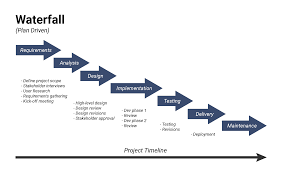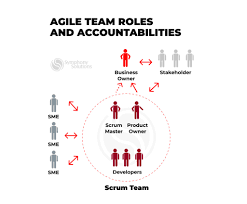Agile Software Development: Embracing Flexibility and Collaboration
In today’s fast-paced and ever-evolving digital landscape, traditional software development methodologies often struggle to keep up with the demands of modern businesses. Enter Agile Software Development, a flexible and collaborative approach that has revolutionized the way software is built.
At its core, Agile Software Development is centered around adaptability and collaboration. Unlike traditional waterfall methods, where development occurs in a linear fashion with predefined stages, Agile embraces change and encourages iterative development cycles. This allows for continuous improvement, quick feedback loops, and the ability to respond to evolving customer needs.
One of the key principles of Agile is its emphasis on individuals and interactions over processes and tools. Agile teams are cross-functional units that collaborate closely throughout the entire development process. This promotes better communication, knowledge sharing, and collective ownership of the project’s success.
Another fundamental aspect of Agile is its focus on delivering working software in short increments called “sprints.” Each sprint typically lasts between one to four weeks, during which a set of prioritized tasks or user stories are completed. This iterative approach enables stakeholders to see tangible progress early on and provide valuable feedback that can be incorporated into subsequent sprints.
Agile methodologies also encourage regular reflection and adaptation through ceremonies such as daily stand-up meetings, sprint planning sessions, and retrospectives. These activities foster continuous learning and improvement within the team by identifying areas for optimization and addressing any challenges or bottlenecks.
One of the most popular frameworks within Agile is Scrum. Scrum provides a clear structure for organizing work into manageable chunks while promoting transparency and accountability. It divides projects into fixed-length sprints with clearly defined goals, roles (such as Product Owner, Scrum Master, and Development Team), and artifacts (such as product backlogs and sprint backlogs).
By embracing Agile Software Development practices, organizations can reap numerous benefits. Firstly, it enables faster time-to-market by delivering valuable features incrementally, allowing businesses to respond swiftly to changing market conditions. Secondly, Agile promotes higher customer satisfaction as it encourages regular feedback and collaboration, ensuring that the end product aligns with user expectations. Additionally, Agile fosters a more motivated and engaged development team by empowering individuals and allowing them to take ownership of their work.
However, it is important to note that Agile is not a one-size-fits-all solution. Each project and organization may require tailoring Agile practices to suit their specific needs. It is crucial to have skilled Agile practitioners who can guide the team through the process and adapt the methodologies accordingly.
In conclusion, Agile Software Development has transformed the way software is built by embracing flexibility, collaboration, and adaptability. By adopting an iterative approach with short development cycles, organizations can deliver high-quality software that meets customer needs while fostering a collaborative and motivated team environment. Embracing Agile methodologies can help businesses stay competitive in today’s rapidly changing digital landscape.
5 Essential Tips for Agile Software Development
- Embrace Iterative Development
- Foster Collaboration
- Prioritize User Stories
- Continuous Integration & Testing
- Regular Retrospectives
Embrace Iterative Development
Embrace Iterative Development: Unlocking the Power of Agile Software Development
In the world of Agile Software Development, one tip stands out as a fundamental principle: Embrace Iterative Development. This approach has proven to be a game-changer for teams looking to build high-quality software in a dynamic and ever-changing environment.
Iterative development refers to the practice of breaking down the software development process into smaller, manageable increments. Instead of attempting to deliver a fully complete product in one go, teams focus on delivering small, functional pieces of software at regular intervals. Each iteration builds upon the previous one, incorporating feedback and improvements along the way.
The benefits of embracing iterative development are numerous. Firstly, it allows for early and continuous feedback from stakeholders, including end-users and customers. By delivering working software in short iterations, teams can gather valuable insights that help shape subsequent iterations. This feedback loop ensures that the final product aligns closely with user needs and expectations.
Secondly, iterative development enables teams to adapt quickly to changes in requirements or market conditions. In traditional waterfall methodologies, changes made late in the development process can be costly and time-consuming. However, with iterative development, teams have the flexibility to adjust their course based on new information or evolving priorities.
Another advantage of embracing iteration is improved risk management. By breaking down a project into smaller increments, teams can identify potential risks earlier and address them proactively. This mitigates the chances of major setbacks or failures by allowing for course corrections during each iteration.
Additionally, iterative development promotes transparency and collaboration within the team. Regular checkpoints and demonstrations ensure that everyone is on the same page regarding progress and goals. It fosters a sense of shared ownership among team members and encourages open communication throughout the project lifecycle.
To successfully embrace iterative development, it is important to establish clear priorities and define achievable goals for each iteration. The team should also regularly review progress against these goals and make necessary adjustments as needed. Embracing a mindset of continuous improvement is key to maximizing the benefits of iterative development.
In conclusion, embracing iterative development is a powerful tip in Agile Software Development. By breaking down projects into smaller increments and delivering working software at regular intervals, teams can gather feedback, adapt to changes, manage risks effectively, and foster collaboration. This approach not only leads to higher-quality software but also ensures that the end product meets user expectations. So, embrace iteration and unlock the true power of Agile Software Development.
Foster Collaboration
Foster Collaboration: The Key to Successful Agile Software Development
In the world of Agile Software Development, collaboration is not just a buzzword; it is a fundamental principle that drives success. By fostering collaboration within development teams, organizations can unlock the full potential of Agile methodologies and deliver outstanding software products.
Collaboration is all about bringing people together, encouraging open communication, and leveraging the collective knowledge and skills of the team. In an Agile environment, this means breaking down silos and promoting cross-functional collaboration between developers, testers, designers, product owners, and other stakeholders.
One of the primary benefits of fostering collaboration in Agile Software Development is improved decision-making. When team members work closely together and share their expertise, they can collectively analyze problems, explore different perspectives, and make informed decisions that lead to better outcomes. This collaborative approach ensures that everyone’s insights are valued and taken into account.
Another advantage of collaboration in Agile is increased efficiency. By promoting regular communication and knowledge sharing, teams can avoid duplication of efforts or misunderstandings that can arise when working in isolation. Collaborative environments empower individuals to ask questions, seek clarification, and resolve issues together in real-time. This leads to faster problem-solving and more streamlined development processes.
Collaboration also enhances creativity and innovation within the team. When diverse minds come together with different skill sets and perspectives, it sparks creativity by encouraging out-of-the-box thinking. Ideas are shared freely, leading to innovative solutions that might not have been possible without collaborative input.
Furthermore, fostering collaboration helps build a positive team culture based on trust and respect. When team members feel heard and valued for their contributions, they become more engaged in their work. Collaboration encourages empathy and understanding among team members as they work towards a common goal. This sense of camaraderie fosters a supportive environment where individuals are motivated to go above and beyond for the success of the project.
To foster collaboration effectively in Agile Software Development, organizations can implement various practices. Regular team meetings, such as daily stand-ups or sprint planning sessions, provide opportunities for open communication and alignment. Collaborative tools and platforms can be utilized to facilitate remote collaboration and ensure everyone has access to relevant information.
It is also essential to establish a culture that encourages collaboration by recognizing and rewarding teamwork. Celebrate achievements collectively and promote a safe space where ideas can be freely shared without fear of judgment. Encourage cross-functional training and knowledge sharing to build a well-rounded team capable of collaborating effectively.
In conclusion, fostering collaboration is a crucial tip for successful Agile Software Development. By breaking down barriers, promoting open communication, and leveraging the collective intelligence of the team, organizations can harness the power of collaboration to deliver outstanding software products. Collaboration not only improves decision-making, efficiency, and creativity but also builds a positive team culture that drives success in Agile endeavors.
Prioritize User Stories
Prioritize User Stories: Putting the User at the Heart of Agile Software Development
In the world of Agile Software Development, one tip stands out as a guiding principle for success: prioritize user stories. User stories are concise descriptions of a feature or functionality from the perspective of an end-user. They serve as a communication tool between stakeholders and development teams, ensuring that everyone is aligned on what needs to be built.
Prioritizing user stories is crucial because it allows development teams to focus their efforts on delivering the most valuable features first. By understanding and addressing the needs and expectations of users, teams can create software that truly adds value and meets customer demands.
When prioritizing user stories, it’s important to consider several factors. One key aspect is business value. Identify which features will have the most significant impact on achieving business goals or solving customer problems. Prioritizing high-value user stories ensures that limited development resources are allocated to areas that will yield the greatest return on investment.
Another factor to consider is user impact. Evaluate how each user story affects the end-user experience. Prioritize those features that directly enhance usability, address pain points, or provide unique selling points. By focusing on improving the user experience, organizations can create software that delights their customers.
Additionally, dependencies should be taken into account when prioritizing user stories. Some features may rely on others being implemented first. By identifying these dependencies early on, development teams can plan accordingly and ensure a smooth workflow.
It’s also important to involve stakeholders in the prioritization process. Engage with product owners, customers, and other relevant parties to gain insights into their priorities and perspectives. This collaborative approach helps align expectations and ensures that everyone’s needs are considered.
Agile frameworks like Scrum often use techniques such as MoSCoW (Must-Have, Should-Have, Could-Have, Won’t-Have) or Weighted Shortest Job First (WSJF) to facilitate the prioritization process. These techniques provide a structured approach to ranking user stories based on their importance and urgency.
By prioritizing user stories, Agile development teams can deliver value early and continuously throughout the software development process. This iterative approach allows for regular feedback, enabling teams to validate assumptions, make necessary adjustments, and ensure that the software meets user expectations.
In conclusion, prioritizing user stories is a fundamental practice in Agile Software Development. By focusing on delivering high-value features that address user needs, organizations can create software that truly adds value and drives customer satisfaction. Through collaboration and thoughtful consideration of factors like business value, user impact, and dependencies, development teams can effectively prioritize their efforts and build successful software products.
Continuous Integration & Testing
Continuous Integration & Testing: Ensuring Quality and Efficiency in Agile Software Development
In the fast-paced world of Agile Software Development, where frequent changes and iterations are the norm, ensuring that the software remains stable and bug-free becomes crucial. This is where Continuous Integration (CI) and Continuous Testing (CT) come into play.
Continuous Integration is a development practice that involves regularly merging code changes from multiple developers into a shared repository. This allows for early detection of integration issues and conflicts, ensuring that the software remains in a consistent state throughout the development process. By integrating code frequently, teams can address conflicts promptly, reducing the risk of major integration problems later on.
Alongside Continuous Integration, Continuous Testing plays a vital role in maintaining software quality. It involves running automated tests on the integrated codebase to identify any defects or regressions promptly. These tests can range from unit tests to functional tests and even performance tests, depending on the project requirements. By continuously testing throughout development, teams can catch bugs early on when they are easier and cheaper to fix.
The combination of Continuous Integration and Continuous Testing offers several benefits to Agile Software Development teams. Firstly, it helps identify issues quickly, allowing for faster feedback loops. Developers can receive immediate notifications if their code breaks existing functionality or introduces new bugs. This accelerates the debugging process and reduces time wasted on troubleshooting later stages of development.
Secondly, CI and CT promote collaboration among team members by encouraging regular communication about code changes and test results. When everyone is working with an integrated codebase and has access to up-to-date test results, it becomes easier to coordinate efforts and resolve any issues collectively.
Moreover, these practices enhance overall software quality by catching problems early in the development lifecycle. Automated tests provide a safety net against regressions as new features are added or existing ones are modified. By continuously validating functionality through automated testing, teams can ensure that each iteration of their software meets predefined quality standards.
To implement Continuous Integration and Continuous Testing effectively, teams should invest in robust automation frameworks and establish clear guidelines for code integration and testing processes. This includes defining coding standards, setting up automated build and test environments, and running tests on a regular basis.
In conclusion, Continuous Integration and Continuous Testing are essential practices in Agile Software Development. By integrating code changes frequently and running automated tests continuously, teams can detect issues early, collaborate effectively, and ensure the delivery of high-quality software. Embracing these practices not only enhances efficiency but also helps build confidence in the software’s stability throughout its development lifecycle.
Regular Retrospectives
Regular Retrospectives: A Key Ingredient for Agile Software Development Success
In the world of Agile Software Development, one practice that stands out as a crucial element for continuous improvement is the regular retrospective. Retrospectives provide teams with a dedicated time and space to reflect on their work, identify areas for improvement, and make meaningful adjustments to their processes.
A retrospective is typically held at the end of each sprint or iteration, allowing team members to collectively review what went well, what didn’t go as planned, and what can be done differently moving forward. This structured reflection helps teams learn from their experiences and adapt their practices accordingly.
One of the primary benefits of regular retrospectives is that they foster open communication and create a safe environment for team members to share their thoughts and ideas. By encouraging everyone’s participation, different perspectives can be brought to the table, leading to valuable insights and innovative solutions.
During a retrospective, teams often use various techniques such as “Start, Stop, Continue” or “Glad, Sad, Mad” to facilitate discussions. These techniques prompt participants to identify actions that should be initiated (start), actions that should be discontinued (stop), and actions that should be continued (continue). This structured approach helps teams focus on actionable items that can bring about positive change.
Regular retrospectives also promote accountability within the team. By openly discussing successes and challenges, team members take ownership of their work and collectively commit to making improvements. This shared responsibility fosters a sense of empowerment and motivates individuals to contribute actively towards achieving project goals.
Furthermore, retrospectives enable teams to identify patterns over time. By consistently reflecting on previous iterations’ outcomes and lessons learned, teams can spot recurring issues or bottlenecks. This allows them to implement preventive measures or make adjustments early on in subsequent sprints, thereby enhancing overall efficiency.
It’s worth noting that conducting retrospectives alone is not enough; it’s equally important to act upon the insights gained. Teams should prioritize and implement the identified improvements in subsequent sprints, ensuring that the retrospective outcomes translate into tangible changes.
In summary, regular retrospectives are a vital practice in Agile Software Development. They provide teams with an opportunity to reflect, learn, and adapt their processes continuously. By fostering open communication, accountability, and a focus on actionable items, retrospectives contribute to the overall success of Agile projects. So, embrace regular retrospectives as an essential ingredient for continuous improvement and watch your team thrive in the world of Agile Software Development.




